LARGE SCROLL – British gun engraver’s term for scrolls whose
spirals are larger than “English fine” and have background area between
the inside leaves. Large scroll is the standard “house” scroll on the
famous Holland & Holland Royal side by side rifles and shotguns but is
used by other British gunmakers on order.
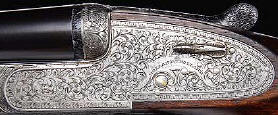
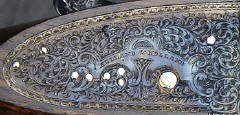
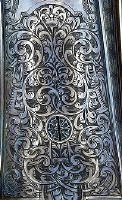

Pictured are the sidelocks from two different Holland & Holland Royal
grade guns which exhibit typical renditions of "large scroll." Shown
next is the floor plate of an H&H Royal and at right the left side of
an E. J. Chruchill showing another variation of "large scroll."
|
LEAF LETTERS – Any style of letters with ornamental leaf design,
usually worked into the main stem of the letter.
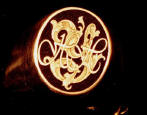
Pictured is the leaf letter Y upon which are superimposed the letters
HH by engraver Steve Lindsay.
|
LETOURNEAU BLOCK – A large, heavy (45 pounds/ 20.4 Kg)
engraver’s block manufactured by Ray Letourneau. Commonly used by those
who engrave guns, motorcycle, and automotive parts.
http://www.handengravetools.com/vises.htm
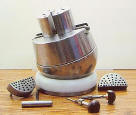
|
LIBERTY – A highly ornate and non-traditional style of
ornamental scrollwork practiced by some gun and knife engravers in
Gardone, Val Trompia, Brescia, Italy. Sometimes referred to as
“spaghetti” engraving by English speaking engravers both for its
Italian design origin and because of its profusion of thin entangled
scrolls.
|
LINDSAY AIR CHASING GRAVER - Working from a spring-pulse design
by Frank Lindsay (father of Steve Lindsay) in 1979, an improved self
oscillation piston principle was patented in 2000 by Steve Lindsay. The
Air Chasing Graver later evolved into the Classic AirGraver made by
Steve Lindsay Engraving & Tools of Kearney, Nebraska. The patented
device can operate with very little air pressure or air volume. In
fact, by simply blowing in it or attaching it to a toy balloon, the
tool will idle. Instead of a spring for the return or impact stroke,
the device uses air pressure for both directions. As a result, the
piston always stays balanced and low or high air pressures can be used
without one side overpowering the other causing the piston to float,
which can occur with the spring-pulse design.
http://patft.uspto.gov/netacgi/nph-P...S=PN/6,095,256
http://www.handengravetools.com/air-...-evolution.htm
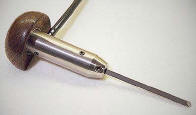
|
LINDSAY ARTISAN AIRGRAVER™ – An air impact engraving system
invented and manufactured by Steve Lindsay Engraving & Tools. The
Artisan AirGraver works in conjunction with compressed air either from
a compressor or bottled CO2 and is controlled by a foot pedal or can be
set up to operate from palm push pressure of a user's hand (PalmControl™)
as an additional cost option. Four components are required to engrave
with an Artisan AirGraver: the Artisan hand piece, a graver, foot
pedal, and compressed air or CO2 source. Only three components are
needed if the PalmControl™ option is used. The Artisan runs at 2400
impacts per minute at idle through 10,000 at 60 PSI when used with the
included stainless piston. When used with a tungsten dead blow piston,
it impacts 1500 times per minute at idle through 7,000 at 60 PSI.
The Artisan AirGraver is not an “engraving machine” in the sense that
it is completely controlled free hand by the engraver. Its main
advantage over hammer & chisel is that the piston within the hand piece
takes the place of a chasing hammer thus freeing one of the engraver’s
hands to turn the engraving block as well as greater control of the
graver than can be supplied by manual power alone.
http://www.handgravers.com/Artisan-AirGraver.htm
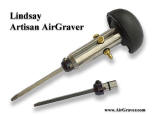
|
LINDSAY CLASSIC™ AIRGRAVER™ – An air impact freehand engraving system invented and manufactured by Steve Lindsay
Engraving & Tools. The Classic AirGraver™ works in conjunction with compressed air either from a compressor or bottled CO2 and is controlled by a foot pedal or
can be set up to operate from palm push pressure of a user's hand (PalmControl™) as an additional cost option. The Classic is similar to the Artisan AirGraver,
but includes the added features of a replaceable bore and a stroke adjustment collar for finer control. Four components are required to engrave with a Classic
AirGraver: the Classic hand piece, a graver, foot pedal, and compressed air or CO2 source. Only three components are needed if the PalmControl™ option is used.
The Classic runs at 1500 through 15,000 impacts per minute.
The Lindsay Classic AirGraver is not an “engraving machine” in the sense that it is completely controlled free hand by the engraver. Its main advantage over
hammer & chisel is that the piston within the hand piece takes the place of a chasing hammer thus freeing one of the engraver’s hands to turn the engraving block
as well as greater control of the graver than can be supplied by manual power alone.
http://www.handgravers.com/Classic.htm
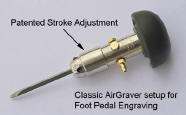
|
LINDSAY DOUBLE BRIGHT CUT– In 1994 while engraving logos for the flute company Brannen Brothers,
Steve Lindsay began using this double bright cut with his patented Uniform Parallel point that was polished to a mirror. The point easily lends itself to
this type of cut. The double bright cut consists of a wide cut made by leaning the graver to one side (single
flare cut) and then a smaller cut following the outside edge of the wide cut.
Click here for a video of this cut being executed.
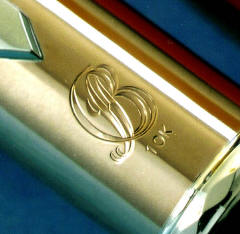 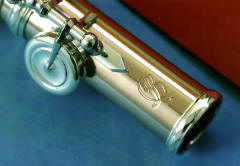
Close-up picture of logo on a Brannen Brothers gold flute showing double bright cut. From 1994 through 2007 Steve cut approximately thirty Brannen Brothers
flutes a month on two locations on the flute with the pictured BC logo and serial number with the double bright cut technique. Below: Flute lip plate
engraved with the double bright cut technique using the Uniform Parallel point.
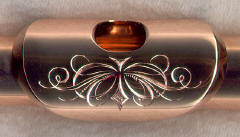
|
LINDSAY ENGRAVING & TOOLS – A manufacturer and vendor of tools
and accessories designed for hand engravers, owned and operated by
Steve J. Lindsay and located in Kearney, Nebraska.
http://www.AirGraver.com
|
LINDSAY OMEGA AIRGRAVER – A larger and more powerful
version of Steve Lindsay’s original Air Chasing Graver. The Omega was
designed for those engraving large items such as automotive and
motorcycle parts, Western bright cut on bits and spurs as well as wood
carving. The Omega has been superceded in recent years by other Lindsay
AirGravers that allow the substitution of a tungsten piston for the
stainless piston to provide heavier impacts.
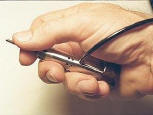
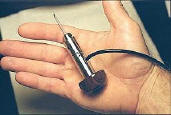

|
LINDSAY PALMCONTROL™ – An air impact freehand engraving system
invented and manufactured by Steve Lindsay Engraving & Tools. The
PalmControl AirGraver™ works in conjunction with compressed air either
from a compressor or bottled CO2 and is controlled by hand pressure
alone without the need for a foot pedal. The PalmControl AirGraver also
features a replaceable bore and a stroke adjustment collar for finer
control. Considered by many to be the most advanced, power freehand
engraving system, the PalmControl or PC, as it is also known, requires
only three components for engraving. The components are the hand piece,
a graver, and a source of compressed air or CO2.
The Lindsay PalmControl is not an “engraving machine” in the sense that
it is completely controlled free hand by the engraver. Its main
advantage over hammer & chisel is that the piston within the hand piece
takes the place of a chasing hammer thus freeing one of the engraver’s
hands to turn the engraving block as well as greater control of the
graver than can be supplied by manual power alone.
http://www.handgravers.com/PalmControl.htm
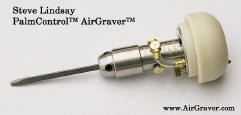
|
LINDSAY SCROLL – A style of ornamental scrollwork popularized by
designer and engraver Steve J. Lindsay of Kearney, Nebraska. Lindsay
scroll is characterized by highly refined and shaded leaf structures
connected to flowing vines (often gold inlayed) with undulating
tendrils.
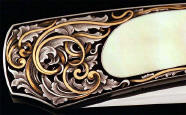
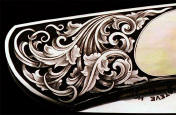
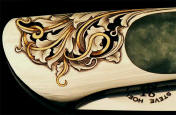
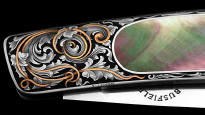
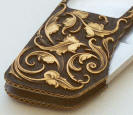
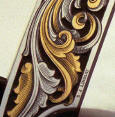

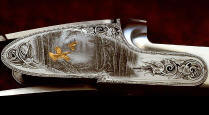
Pictured here are eight examples of Lindsay scroll on a variety of
objects.
|
LINDSAY SHARPENING TEMPLATES – The concept of sharpening
templates was a collaboration between tool maker Paul Hammler and Steve
Lindsay to solve the problem of properly sharpening gravers with
consistent, repeatable angles for good cutting in a variety of
situations. After the original basic templates were created, their
popularity with hand engravers was such that several internationally
known engravers added additional designs for specialized uses. Along
with Lindsay and Hammler, other template designers include Roland
Baptiste of Belgium, Carl Bleile of Cincinnati USA, and Phil Coggan of
Wales, UK.
http://www.handengravetools.com/sharpening.htm
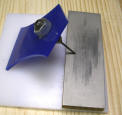
|
LINDSAY UNIFORM-PARALLEL POINT™ – The Patented Lindsay
Uniform-Parallel Point™ is a V shaped graver point with relieved heels
that works with any width V graver point, from a narrow V to a wide V.
The most noticeable feature of the geometry is parallel width heels
with two long secondary relief facets on the bottom of the point. U.S.
Patent # 7,032,586
http://www.engravingtraining.com/pri...oint-Intro.htm
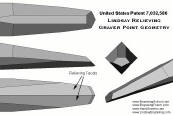
|
LINE ENGRAVING – 1. A scene or figure engraved into metal using
fine lines, not so detailed or realistic in appearance as a bank note
style engraving. 2. Scroll or floral engraving without background
matting or relief.
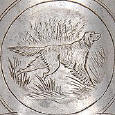
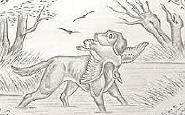
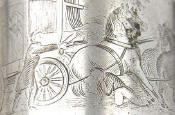
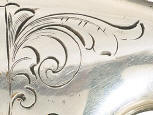
Pictured are three examples of simple line engraved scenes and a basic
line engraved scroll.
|
LINER – An engraving chisel that cuts several parallel lines
simultaneously. Also known as a “threader” or “stitch tool.”

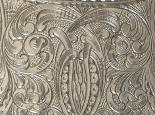
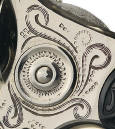
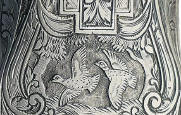
Pictured is the profile of a liner. The next picture illustrates
scrollwork shaded with a liner. The third picture illustrates simple
scroll leaves formed by a liner and the last picture shows background
treatment with a liner in a scene.
|
LOADING - While engraving certain metals, such as aluminum,
brass, or copper, a deposit of the metal will build up on the heel of
the graver causing a dulled appearance to the cut. Engravers dip the
tip of the graver into any of a number of preferred oils to prevent
loading. Also known as “picking-up” or “build-up.”
|
LOADING GATE – In a revolver having a cylinder that does not
move away from the breech for loading, it refers to a hinged portion of
the standing breech that swings out to expose one of the chambers of
the cylinder for loading and unloading, The loading gate of a revolver
is one of the components to be engraved when the receiver or frame is
to be decorated with engraving. Loading gates are also found on lever
action rifles and carbines. Such loading gates are usually a dished out
piece of spring loaded steel covering the access to a tubular magazine.
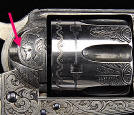
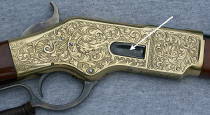
Shown here is the engraved loading gate of an antique Colt (arrow) and
the loading gate (arrow) of a lever action carbine engraved by Roger
Bleile.
|
LOCK PLATE – Often engraved with scrollwork and the gun maker’s
name, the lock plate is the steel portion of a firearm that carries the
lock work (mainspring, sear, and bridle) on the underside and the
hammer or “cock” on the external side. On hammerless rifles and
shotguns the lock plate is also known as a “side lock.”
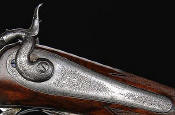
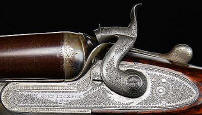
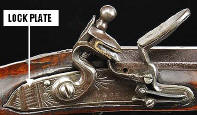
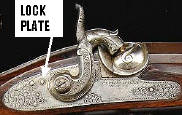
Shown respectivly are the lock plates of a back action lock, a bar
action lock, a flint lock, and a percussion lock.
|
LOUPE – A small magnifying glass made to either be held in the
recess of the eye or in the hand, used by jewelers and engravers.

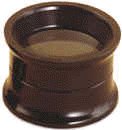
Shown here are examples of an eye held loupe and a hand held loupe.
|
LOZENGE GRAVER – A traditional graver shape which when viewed
from the face, the un-ground graver has a narrow diamond profile. Used
for cutting deep but narrow lines. Lozenge gravers come in sizes from
#16 to #19.
|